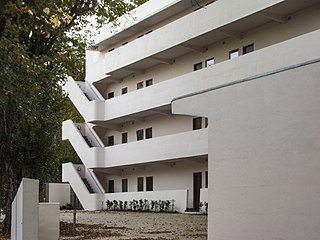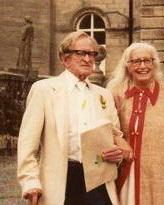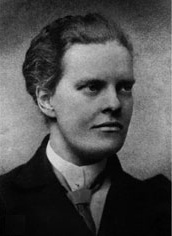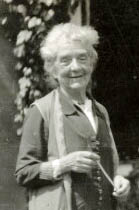
The Staatliches Bauhaus, commonly known as the Bauhaus, was a German art school operational from 1919 to 1933 that combined crafts and the fine arts. The school became famous for its approach to design, which attempted to unify the principles of mass production with individual artistic vision and strove to combine aesthetics with everyday function.

Walter Adolph Georg Gropius was a German-American architect and founder of the Bauhaus School, who, along with Alvar Aalto, Ludwig Mies van der Rohe, Le Corbusier and Frank Lloyd Wright, is widely regarded as one of the pioneering masters of modernist architecture. He is a founder of Bauhaus in Weimar (1919). Gropius was also a leading architect of the International Style.

Selly Oak is an industrial and residential area in south-west Birmingham, England. The area gives its name to Selly Oak ward and includes the neighbourhoods of: Bournbrook, Selly Park, and Ten Acres. The adjoining wards of Edgbaston and Harborne are to the north of the Bourn Brook, which was the former county boundary, and to the south are Weoley, and Bournville. A district committee serves the four wards of Selly Oak, Billesley, Bournville and Brandwood. The same wards form the Birmingham Selly Oak constituency, represented since 2010 by Steve McCabe (Labour). Selly Oak is connected to Birmingham by the Pershore Road (A441) and the Bristol Road (A38). The Worcester and Birmingham Canal and the Birmingham Cross-City Railway Line run across the Local District Centre.

Isokon Flats, also known as Lawn Road Flats and the Isokon building, on Lawn Road in the Belsize Park district of the London Borough of Camden, is a reinforced concrete block of 36 flats, designed by Canadian engineer Wells Coates for Molly and Jack Pritchard.

Frederick Louis MacNeice was a Irish poet and playwright from Northern Ireland, and a member of the Auden Group, which also included W. H. Auden, Stephen Spender and Cecil Day-Lewis. MacNeice's body of work was widely appreciated by the public during his lifetime, due in part to his relaxed but socially and emotionally aware style. Never as overtly or simplistically political as some of his contemporaries, he expressed a humane opposition to totalitarianism as well as an acute awareness of his roots.

Walter Ernest Allen was an English literary critic and novelist and one of the Birmingham Group of authors. He is best known for his classic study The English Novel: a Short Critical History (1951).

The London-based Isokon firm was founded in 1929 by the English entrepreneur Jack Pritchard and the Canadian architect Wells Coates to design and construct modernist houses and flats, and furniture and fittings for them. Originally called Wells Coates and Partners, the name was changed in 1931 to Isokon, a name derived from Isometric Unit Construction, bearing an allusion to Russian Constructivism.

Bournbrook is an industrial and residential district in southwest Birmingham, England, in both the Selly Oak Council Ward and the Parliamentary District of Selly Oak. Prior to what is commonly termed the Greater Birmingham Act, which came into effect on 9 November 1911, the Bourn Brook watercourse was the North Eastern boundary of Worcestershire, and the area was locally governed by the King’s Norton and Northfield Urban District Council.

Edwin Maxwell Fry, CBE, RA, FRIBA, FRTPI, known as Maxwell Fry, was an English modernist architect, writer and painter.

Alix Strachey, née Sargant-Florence, was an American-born British psychoanalyst and, with her husband, the translator into English of The Standard Edition of the Complete Psychological Works of Sigmund Freud.

Ethel Sargant was a British botanist who studied both the cytology and morphology of plants. She was one of the first female members of the Linnean Society and the first woman to serve on their council. She was the first woman to preside over a Section of the British Association. At Cambridge, she was elected an Honorary Fellow of Girton College in 1913 and also became President of the British Federation of University Women from 1913 until 1918.
The Office of High Sheriff of the West Midlands is the ceremonial position of High Sheriff appointed to the West Midlands, a metropolitan county in central England. The appointment is made by the British monarch by Pricking the Lists. Created in 1974, the office of High Sheriff of the West Midlands has the duty to "protect and assist in upholding the dignity and well being of Her Majesty’s judges and to represent the Queens executive powers in respect of the administration of justice in the county". The Office of High Sheriff is normally awarded to people of stature in the West Midland who have significantly and positively contributed in some way to the county's community either through voluntary work or through commerce or industry.
John Craven (Jack) Pritchard was a British furniture entrepreneur, who was very influential between the First and Second World Wars. His work is exhibited in the Victoria and Albert Museum and the Museum of London. He was a member of the Design and Industries Association.
Selly Park is a residential suburban district in south-west Birmingham, England. The suburb of Selly Park is located between the Bristol Road (A38) and the Pershore Road (A441).

St. George's Church, Edgbaston, is a parish church in the Church of England in Edgbaston, Birmingham.
The Birmingham Group was a group of authors writing from the 1930s to the 1950s in and around Birmingham, England. Members included John Hampson, Walter Allen, Peter Chamberlain, Leslie Halward and Walter Brierley.

Emma Mary Sargant Florence was a British painter of figure subjects, mural decorations in fresco and occasional landscapes in watercolour and pastel.
Philip Sargant Florence was an American economist who spent most of his life in the United Kingdom.

The literary tradition of Birmingham originally grew out of the culture of religious puritanism that developed in the town in the 16th and 17th centuries. Birmingham's location away from established centres of power, its dynamic merchant-based economy and its weak aristocracy gave it a reputation as a place where loyalty to the established power structures of church and feudal state were weak, and saw it emerge as a haven for free-thinkers and radicals, encouraging the birth of a vibrant culture of writing, printing and publishing.

Lella Secor Florence, née Lella Faye Secor, was an American writer, journalist, pacifist, feminist and pioneer of birth control.













